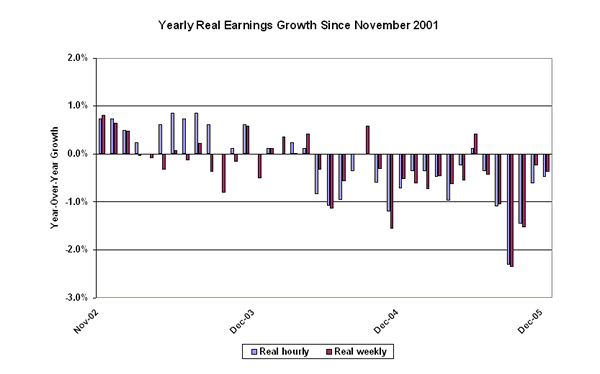January 18, 2006
Wages down for second full year in 2005
Adjusted for inflation, hourly and weekly earnings fell for most workers in 2005, according to today’s report (Table B) from the Bureau of Labor Statistics.
Real hourly earnings were down 0.5% and weekly earnings fell by 0.4% between December 2004 and December 2005 (note that these values, reported by the BLS, use a different measure of price growth, the CPI-W, which rose slightly faster than the CPI-U last year). As shown in the chart below, on a year-over-year basis, real hourly earnings have fallen 18 out of the last 20 months (17 of 20 months for weekly earnings). The decline in real wages results from both faster inflation over the course of 2005 (up 3.4% for the year, and the fastest yearly price growth since 2000) and slower nominal wage growth over the past few years especially when compared to the pace that prevailed before the jobless recovery.

Using the CPI-U, in real terms the average wage of non-managerial workers (roughly 80% of the workforce) was $16.34 in December 2005, just about the same level in real dollars as the $16.36 level that prevailed in November 2001, the month the current recovery began. The comparable weekly values are $551 (November 2001) and $553 (December 2005). Thus, after over four years of a recovery that has been touted by some as healthy and robust, most workers’ buying power remains unchanged. This lack of progress is especially unsettling given the 13.5% growth in labor productivity over this period (2001q1-2005q3).
Taking the average over the full year of 2005, hourly earnings fell 0.6% compared to 2004 (coincidentally, 2004 also saw an 0.6% annual average wage loss compared to 2003). The chart below plots annual real wages from 1989 to 2005. After falling in the early 1990s downturn, and then stagnating in the initially weak recovery that followed, real wages grew solidly through the rest of the 1990s. The momentum of that full employment job market kept real wages rising through 2003, before reversing course over the past two years.

By EPI economists Jared Bernstein and Sylvia A. Allegretto.
To view archived editions of WAGES PICTURE, click here.
